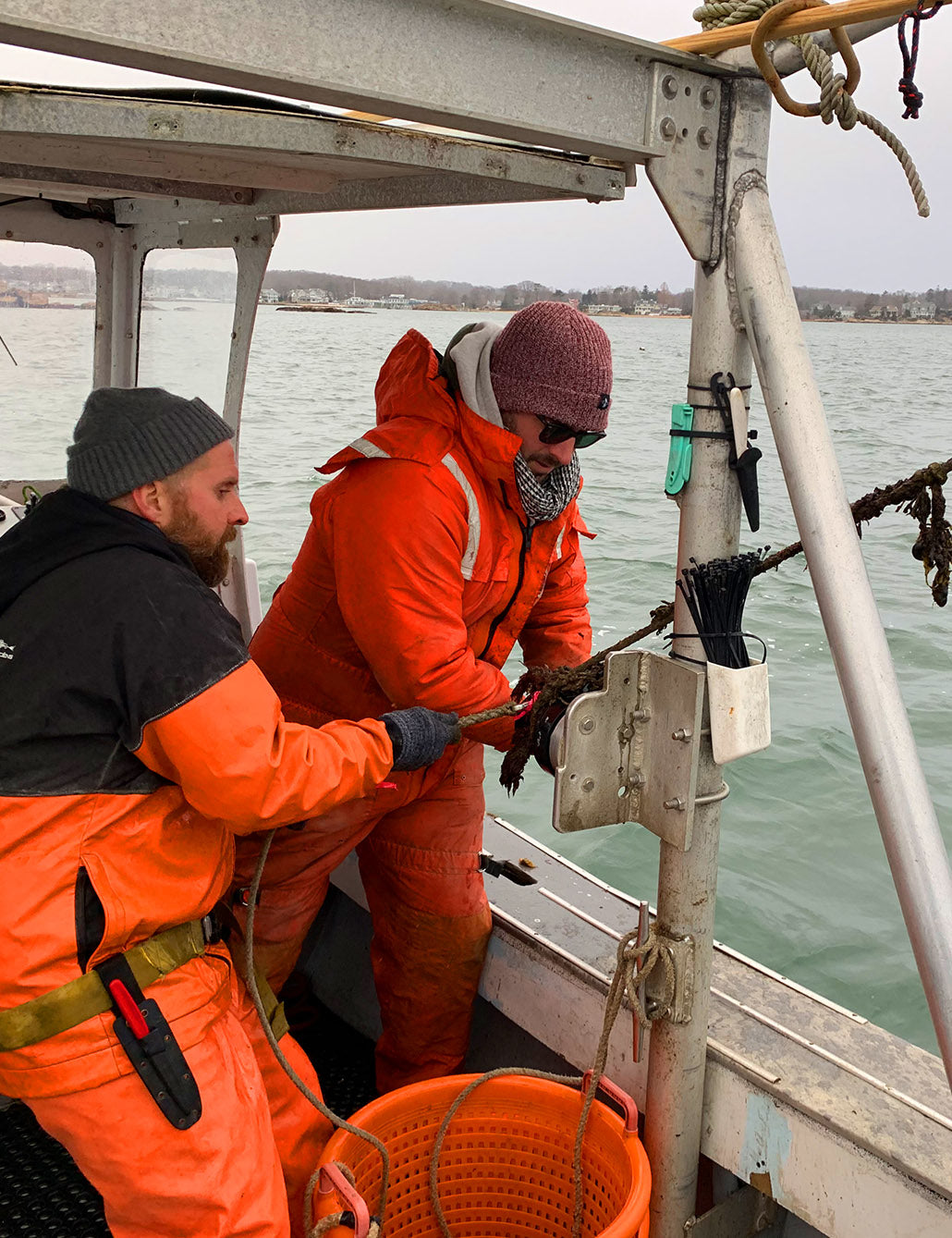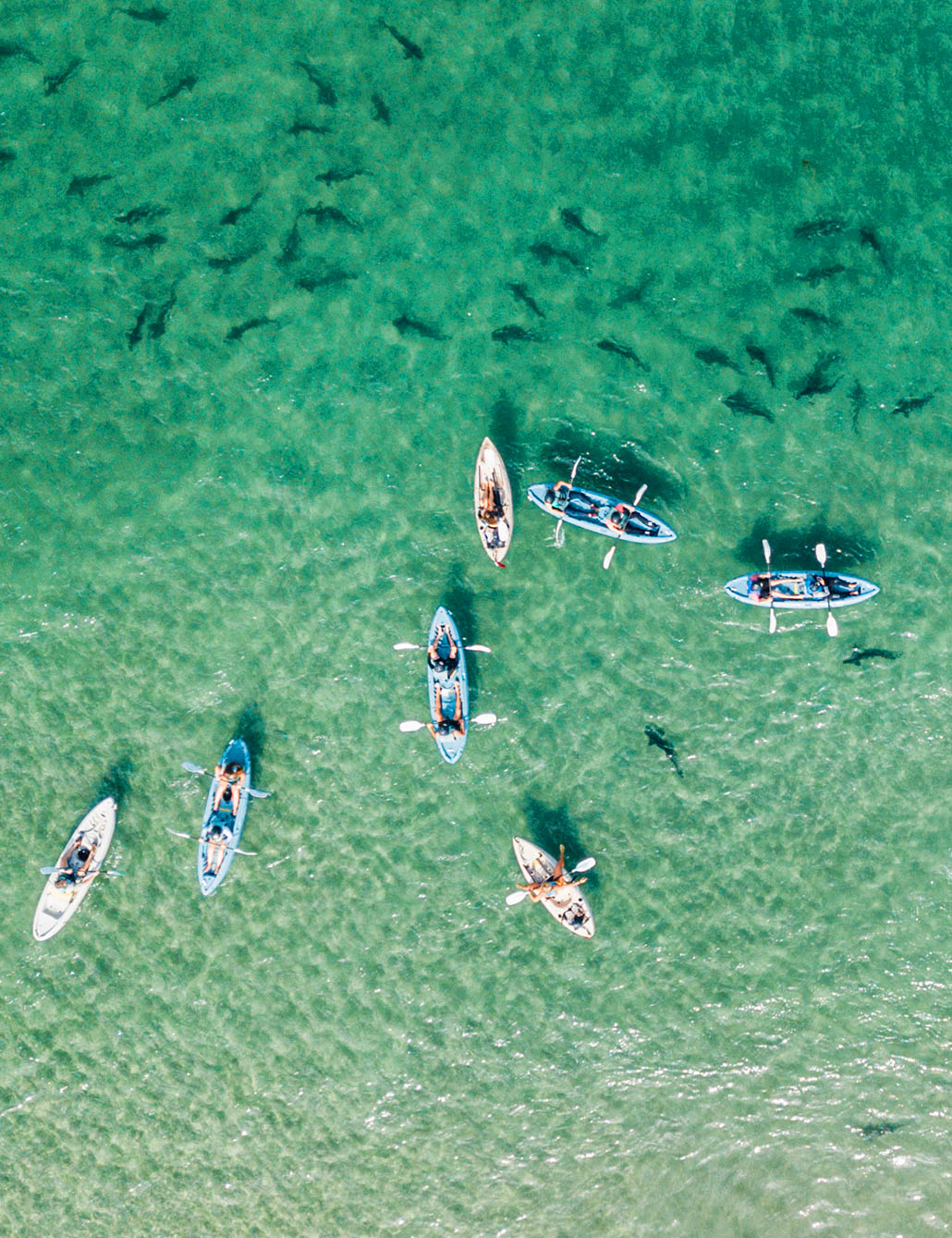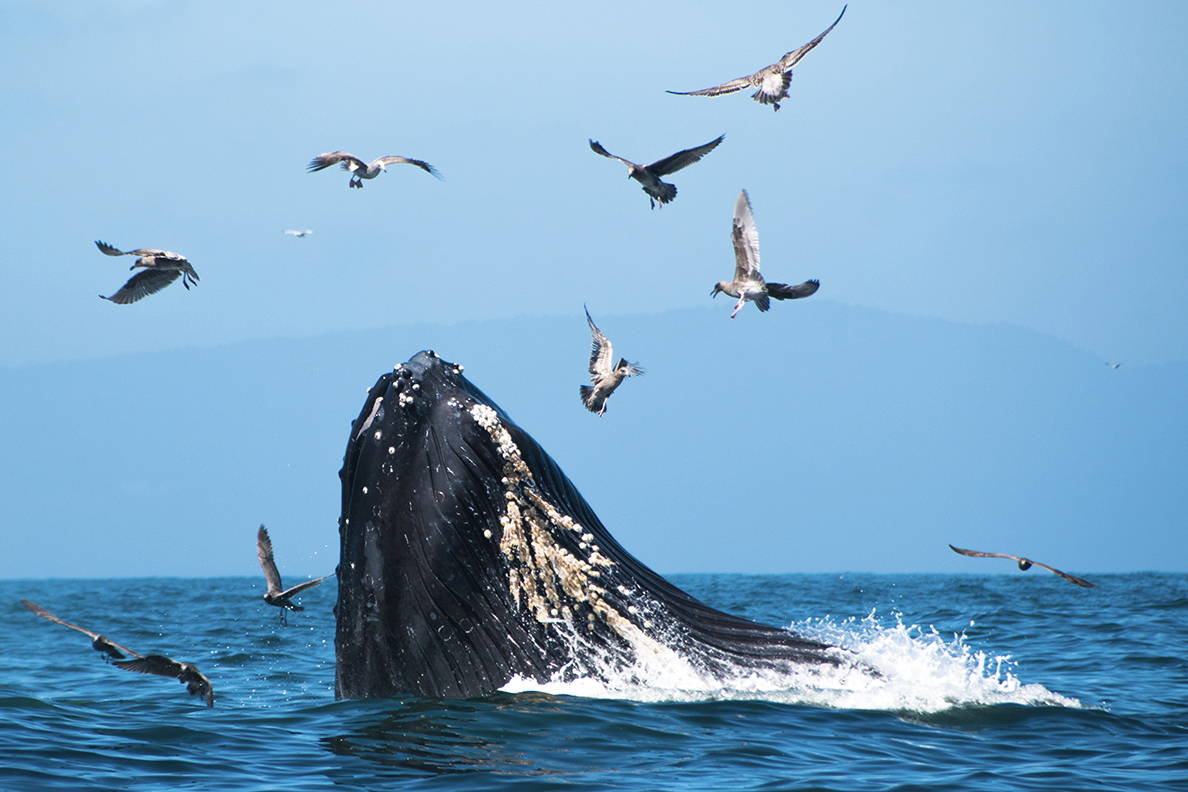By Andrew Iida I Head Writer and Resident EMT
La Jolla's Ecological Reserve was established to protect and conserve marine life, associated habitats and ecosystems. The reserve starts at the Seven Sea Caves and extends north to Scripps Pier. This remarkable stretch of water is home to La Jolla's Underwater Park, part of La Jolla's Submarine Canyon, giant kelp forests and rocky reef. The preserve shelters numerous species, including Leopard Sharks, Sea Turtles, Sea Lions, Dolphins and migrating Whales. Only 2% of the world's ocean water is protected by state and federal law, which also makes La Jolla's ecological reserve a rare place to see undisturbed wildlife in their natural habitat.
Garibaldi

The garibaldi damselfish, California’s state fish, is one of the easiest animals to spot while swimming in La Jolla. The bright orange adults look like goldfish on steroids, and they stand out against the green algae and seaweed. The juveniles are not as bright as the adults, but their darker scales are speckled with iridescent blue spots and lines that almost seem to glow when the sun catches them. Garibaldis eat small invertebrates (shrimp, anemones, worms, etc.) from the rocks on the sea floor.
Fun fact: They are named after Giuseppe Garibaldi, an Italian general who helped create the Kingdom of Italy and wore bright red shirts into battle.
California Sea Lions

The sea lions in La Jolla can usually be seen on the beach and rocks next to the ocean, resting and soaking up the sun. When they get in the ocean, these powerful swimmers hunt for fish and squid, and you might see a nearly 800 pound animal jump clear out of the water. Sea lions are not usually aggressive, but when they feel threatened, they can be dangerous (there’s a reason the U.S. Navy uses trained sea lions to protect boats and harbors). Be sure to follow the NOAA guidelines and stay 100 feet away from sea lions on land and 50 yards away from sea lions in the water.
Fun fact: You can easily tell seals and sea lions apart by looking for ears. Sea lions have external ear structures, so if the animal an ear hole, it’s a seal. If it has an ear flap that sticks out, it’s a sea lion.
Sea Turtles

We’ve been having great luck with seeing sea turtles on our kayak tours lately. Despite the name, their shells range from dark olive to black (hence their other name, Black Sea Turtles). Juvenile green sea turtles are carnivores and eat mostly invertebrates, fish eggs, and lots of jellies. When they reach maturity, they also eat sea grass. Unfortunately, green sea turtles are endangered, mostly due to human activity. Plastic bags floating in the water look just like jellies, but they get stuck in the turtles’ throats. Let’s keep our oceans clean and our turtles safe!
Fun fact: Green sea turtles can sleep underwater for hours at a time.
Leopard Sharks

Don’t worry; they’re harmless! These sharks can grow to more than five feet and come to the shallow waters in La Jolla for their breeding season from June to October. August is usually the peak month for leopard sharks here at the Shores, and on a good day, you might be swimming with dozens, scores, or even hundreds of leopard sharks. They eat small invertebrates that live in the sand, so humans have nothing to worry about.
Fun Fact: La Jolla is the only place in the world that leopard sharks have been observed mating.
Grunion

Want to see fish up close without getting wet? You’re in luck! California and Baja California are the only places in the world where grunion live. These small, silver fish have no teeth and mostly eat plankton. In the water, they’re not the most interesting animal, but their breeding season is incredible. During high tides on spring and summer nights, grunion catch waves all the way up to the sand, where they flop around on the beach before burying themselves in the sand to lay eggs. When we have “grunion runs”, thousands and thousands of these fish can be seen on the beach next to the waves. Anyone can catch grunion from June to March, as long as you have a fishing license if you’re 16 or older. You can only catch them with your bare hands, so you can’t use a net or dig a hole, but there’s no limit, so catch as many as you can eat.
Fun Fact: A grunion run is described in The Last Tycoon, F. Scott Fitzgerald’s final, unfinished novel.
Round Stingray

These rays are a common sight in La Jolla. Their round shape comes from a large pectoral fin that’s usually about a foot wide when the ray reaches maturity. One of the main reasons to look for these animals is so that you don’t step on them! Round stingrays have a barbed spike on the end of their tail and can deliver a venomous sting that, while non-fatal, can be very painful. The best way to avoid stepping on a round stingray is to shuffle your feet through the sand while you’re walking in the water. The vibrations will scare away the rays and give them plenty of time to avoid being stepped on (they don’t like being stepped on just as much as we don’t like stepping on them). They stay close to the sand, so they’re safe to observe from above if you’re snorkeling.
Fun fact: Despite the persistent myth, peeing on a stingray or jelly sting will not help. If you are stung by either one, just head to the nearest lifeguard tower.
Gray Whales

These whales are the first animals on this list that cannot be seen year round in La Jolla. They spend half of the year in Canada, and starting in October, they begin a migration along the coast all the way to Mexico to birth their calves. Gray whales are baleen whales, which means that their mouths are full of brush-like bristles made of keratin. They take huge mouthfuls of sea water and then force it through the baleen, which traps small crustaceans like shrimp. Adult gray whales can be 50 feet long and 40 tons. They are very intelligent and curious mammals, so while it is illegal to approach them, they sometimes do approach us on our whale watching kayak tours.
Fun fact: Even though they’re eating tiny shrimp and other crustaceans, adult gray whales eat up to 2,400 lbs of food every day.
California Sheephead

Have you ever seen a transgendered fish? Every single California sheephead is born as a female, and some of them later change into males. We don’t fully understand the process and what triggers it, but we know that the ovaries disappear and testes grow during the transition. These fish are hard to miss in the water. Adults can be 3 feet long, and the red and black males don’t blend into the environment very well. They eat lots of sea urchins, crabs, and mollusks, and normally forage for food during the day. Due to high rates of commercial fishing for California sheepheads, the species’ conservation status is listed as “Vulnerable”.
Fun fact: Because California sheephead eat so many sea urchins, they are an important species for the health of our kelp forests. Urchins eat lots of kelp, so more sheepheads means fewer urchins, which means more kelp, which means more fish overall.
Brown Pelican

The brown pelican is a very common sight here in La Jolla, which is fantastic news because they were nearly extinct in the last century. The species was almost wiped out in the 1960’s, mainly due to our use of DDT as a pesticide, which caused the pelican’s egg shells to become too thin to reach maturity. Now, the brown pelican’s conservation status is “Least Concern” because human conservation efforts have allowed the species to thrive once again. Pelicans hunt for fish by diving into the ocean and filling up their neck pouch with a large scoop of water. After expelling the water, they swallow the fish trapped inside.
Fun Fact: The first National Wildlife Refuge was established in 1903 by President Theodore Roosevelt to protect brown pelicans on Pelican Island. We now have 562 refuges around the country.
Orca

I’ll be honest. I’ve lived in San Diego for most of my life, and I’ve never seen an orca outside of captivity, but after last year, they deserve a spot on this list. In September, a pod of five orcas came within 30 feet of the shore in La Jolla. Crowds on the beach were delighted, and I’ve been jealous of them ever since. Orcas are expert hunters, and commonly eat fish, seals, whales, birds, and even great white sharks. Despite the name “killer whales”, there has never been a documented fatal attack on humans from a wild orca, so if you see one swimming near you while you’re on a kayak, just relax and enjoy the view. We aren’t prey to them. In fact, orcas used to help whalers by herding whales into bays for humans to hunt, in exchange for a share of the whale meat.
Fun fact: The scientific classification of orcas puts them in the oceanic dolphin family, so they are the world’s largest species of dolphin. However, oceanic dolphins are part of the toothed whale family, so while it’s more accurate to call them dolphins, you can still call them whales.








